Short-Film Week: Introductory Thoughts
 Short movies are at once the most ubiquitous and the most neglected films there are, garnering little critical appraisal as objects themselves even as they’re unavoidable in everyday life.
Short movies are at once the most ubiquitous and the most neglected films there are, garnering little critical appraisal as objects themselves even as they’re unavoidable in everyday life.
 Short movies are at once the most ubiquitous and the most neglected films there are, garnering little critical appraisal as objects themselves even as they’re unavoidable in everyday life.
Short movies are at once the most ubiquitous and the most neglected films there are, garnering little critical appraisal as objects themselves even as they’re unavoidable in everyday life.
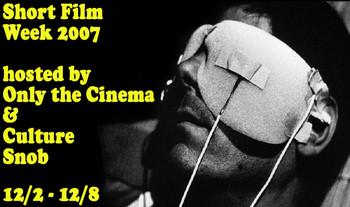 From December 2 through 8, Culture Snob and Ed Howard’s Only the Cinema are hosting the Short-Film Week blog-a-thon.
From December 2 through 8, Culture Snob and Ed Howard’s Only the Cinema are hosting the Short-Film Week blog-a-thon.
 When I read the initial announcement for “Short Film Day,” slated for December 4 at Ed Howard’s Only the Cinema, my heart sank. I’d been mulling a short-film blog-a-thon for months, but was hesitant to set a date because of my experience with the Misunderstood Blog-a-thon; these things are a lot more work than I’d imagined. So Ed beat me to it. But then my barnacle/parasite/moocher antennae got all tingly, and I proposed that we co-host the blog-a-thon and expand it. He agreed.
When I read the initial announcement for “Short Film Day,” slated for December 4 at Ed Howard’s Only the Cinema, my heart sank. I’d been mulling a short-film blog-a-thon for months, but was hesitant to set a date because of my experience with the Misunderstood Blog-a-thon; these things are a lot more work than I’d imagined. So Ed beat me to it. But then my barnacle/parasite/moocher antennae got all tingly, and I proposed that we co-host the blog-a-thon and expand it. He agreed.
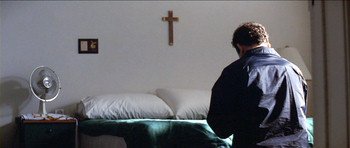 The first images of Jim Kurring involve his morning routine, and it’s nothing remarkable: He eats, he showers, he reads the paper, he exercises. But there are little hints about how we’re supposed to react to him. He laughs out loud – and not very convincingly – at something on the Today show. When he’s lifting weights, we see one of those inspirational posters encouraging “determination.” And he prays, on his knees at the foot of his bed, with a cross looking down upon him. When he finishes, he gets up and claps his hands together once, as if Team God had just broken from the huddle. We learn through voice-over that he participates in some dating service, or at the least runs a personal ad. He’s a cop, and he gives himself a pep talk in the squad car.
The first images of Jim Kurring involve his morning routine, and it’s nothing remarkable: He eats, he showers, he reads the paper, he exercises. But there are little hints about how we’re supposed to react to him. He laughs out loud – and not very convincingly – at something on the Today show. When he’s lifting weights, we see one of those inspirational posters encouraging “determination.” And he prays, on his knees at the foot of his bed, with a cross looking down upon him. When he finishes, he gets up and claps his hands together once, as if Team God had just broken from the huddle. We learn through voice-over that he participates in some dating service, or at the least runs a personal ad. He’s a cop, and he gives himself a pep talk in the squad car.
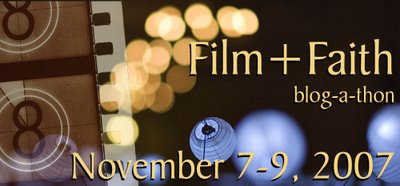 At Strange Culture, RC is hosting the Film + Faith Blog-a-thon, running through November 9. (The announcement is here.) I’m hoping for a diverse, engaging, thoughtful, and provocative batch of essays, because the spiritual component of movies is critical but often neglected.
At Strange Culture, RC is hosting the Film + Faith Blog-a-thon, running through November 9. (The announcement is here.) I’m hoping for a diverse, engaging, thoughtful, and provocative batch of essays, because the spiritual component of movies is critical but often neglected.
 The morning after the Red Sox won the 2007 World Series (following two miserable seasons of championship drought), two people approached me in McDonald’s. I was wearing a Red Sox shirt. We were in northern Arkansas, beginning an 11-hour drive north after a weekend of wedding festivities. Incidentally, I eat at McDonald’s about as often as the Red Sox win the World Series.
The morning after the Red Sox won the 2007 World Series (following two miserable seasons of championship drought), two people approached me in McDonald’s. I was wearing a Red Sox shirt. We were in northern Arkansas, beginning an 11-hour drive north after a weekend of wedding festivities. Incidentally, I eat at McDonald’s about as often as the Red Sox win the World Series.
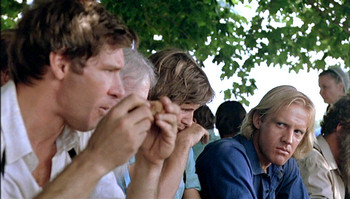 More than a half-century separates these two movies, and they obviously live in different parts of town. Tod Browning’s horror classic Freaks was controversial upon its release in 1932 and hasn’t lost much shock value, with its use of real sideshow performers and the uncomfortable mixture of exploitation and sympathy. Peter Weir’s Witness is a mild drama about the Amish that masquerades as a cop thriller. (Or is a cop thriller disguised as an Amish drama?) Yet the two have much in common.
More than a half-century separates these two movies, and they obviously live in different parts of town. Tod Browning’s horror classic Freaks was controversial upon its release in 1932 and hasn’t lost much shock value, with its use of real sideshow performers and the uncomfortable mixture of exploitation and sympathy. Peter Weir’s Witness is a mild drama about the Amish that masquerades as a cop thriller. (Or is a cop thriller disguised as an Amish drama?) Yet the two have much in common.
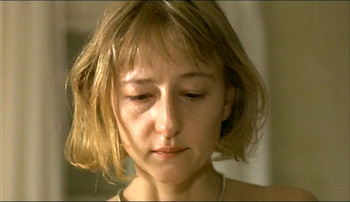 Writer/director Michael Haneke’s 1997 film Funny Games feels like a response to something that hadn’t happened yet. Sure, we’d had Natural Born Killers and other ultra-violent movies, but the fetishism of agony hadn’t yet become a crass trend.
Writer/director Michael Haneke’s 1997 film Funny Games feels like a response to something that hadn’t happened yet. Sure, we’d had Natural Born Killers and other ultra-violent movies, but the fetishism of agony hadn’t yet become a crass trend.
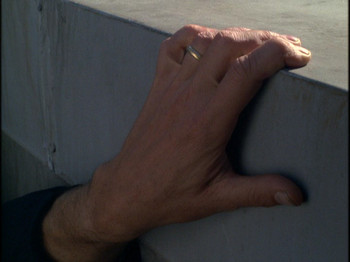 There are dozens of close-ups of hands in Peter Weir’s Fearless, and mostly the extremities belong to Max Klein, the distant plane-crash survivor played by Jeff Bridges. What follows is not a comprehensive catalog but covers the majority of these shots. They are presented in the order in which they appear in the movie.
There are dozens of close-ups of hands in Peter Weir’s Fearless, and mostly the extremities belong to Max Klein, the distant plane-crash survivor played by Jeff Bridges. What follows is not a comprehensive catalog but covers the majority of these shots. They are presented in the order in which they appear in the movie.
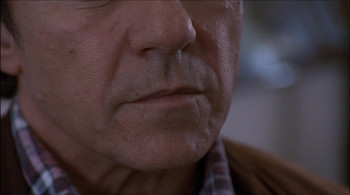 Smoke begins in Auggie Wren’s cigar shop with omniscient chatter about the Mets and ends in a deli with a made-up tale about how Auggie got his first camera. Almost everything in between is also bullshit, in the sense that its relationship with objective reality is utilitarian. We speak the truth when it suits our needs, but we shouldn’t let it get in the way of the story we’re trying to spin.
Smoke begins in Auggie Wren’s cigar shop with omniscient chatter about the Mets and ends in a deli with a made-up tale about how Auggie got his first camera. Almost everything in between is also bullshit, in the sense that its relationship with objective reality is utilitarian. We speak the truth when it suits our needs, but we shouldn’t let it get in the way of the story we’re trying to spin.